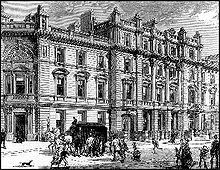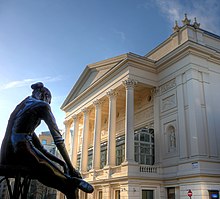Bow Street

Bow Streetis a thoroughfare inCovent Garden,Westminster,London. It connectsLong Acre,Russell Street and Wellington Street, and is part of a route fromSt GilestoWaterloo Bridge.
The street was developed in 1633 byFrancis Russell, 4th Earl of Bedfordfor residential purposes. A number of notable people lived here in the 17th and 18th centuries, includingOliver CromwellandRobert Harley, 1st Earl of Oxford.In the 18th century, the street declined as a place of residence following the establishment of the nearbyCovent Garden Theatre,which led to a reputation for prostitution. During the 19th century, Bow Street was ade factoextension ofCovent Gardenand its associated markets, selling then-exotic fruit and vegetables.[1]
Bow Street has a strong connection with the law; theBow Street Runners,an early voluntary police force, was established here byHenry Fieldingin 1750, and theMetropolitan Police Serviceoperated a station house from 1832, which led to the construction of theBow Street Magistrates' Court.
Today, only a short run of buildings from No. 35 to Russell Street remain on their original sites; the rest having been given up for large buildings.[2]
Geography
[edit]Bow Street is around 0.1 miles (0.16 km) long and runs between Russell Street and Long Acre, to the east of Covent Garden. South of Russell Street, the road continues as Wellington Street towardsThe Strand.As with several other streets in the local area, signs featuring its name are marked with the "Theatreland"logo.[3][4]The street has historically been part of a through route fromSt GilestoWaterloo Bridge,though it is no longer the recommended signposted route.[2]
The nearest tube station isCovent Garden.[5]No bus services run along Bow Street, though the route ofLondon Buses route RV1(from Covent Garden to Waterloo Bridge) is close by.[6]
Bow Street was part of aB road,numbered B401, along with Wellington Street; but it has now been declassified and onlyEndell Streetnow bears the number.[7]
History
[edit]Early history
[edit]
The area around Bow Street was first developed byFrancis Russell, 4th Earl of Bedfordin 1633.[3]Buildings were first erected on the west side of the street that year, and it was fully built by around 1635–36. Development to the northeast was restricted by a brick wall that had been built by the Earl's cousin,Edward Russell, 3rd Earl of Bedford,in 1610 as a land boundary and remained undeveloped for some time. It was eventually built on between 1673 and 1677, with eleven properties constructed.[2]
The street was named Bow Street in 1638 after its basic shape. It was always the Earl's intention to extend it as far asLong Acre,but this was delayed.[2]It was eventually connected by his son,William Russell, 1st Duke of Bedford,who gave ownership of the street over to the Paving Commissioners of St. Martin in the Fields, so it could be a public right of way.[2]
Bow Street had a number of notable residents in the 17th and 18th centuries.Oliver Cromwellmoved to the street in 1645.Robert Harley, 1st Earl of Oxfordwas born there in 1661.[3]Charles Sackville, 6th Earl of Dorsetlived here around 1685.[2]The woodcarverGrinling Gibbonshad premises on Bow Street between 1678 and 1721,[3]while the physicianJohn Radcliffestayed on the street in the 1680s. Author andscribeJohn Ayresstayed at Bow street during the late 17th century, as did the playwrightWilliam Wycherley.[2]The actor-managerDavid Garricklived at No. 6 between 1742 and 1744[3]whileCharles Macklinstayed in the street between 1743 and 1748.[2]
Will's Coffee House was founded at No. 71 Bow Street in 1671 by William Urvin. It became popular during the 1690s, extending to No. 20 Russell Street, and survived until 1751.[2]
Many residents moved away from Bow Street after the theatre was established in the early 18th century. Life in the street declined and became known forpornographyandprostitution.[2]The publisherEdmund Curlllived at No. 2 during this time, and by 1740 the street held 8 pubs, concealing a number ofbrothels.[3][8]In 1833, the Commissioners of Woods, Forest and Land Revenues were looking to buy land on and around Bow Street, and discovered that James Robinson, lessee to the Duke of Bedford, was running a brothel there. In the following legal dispute, Robinson's legal team accused the Commissioner's surveyor of being prejudiced against prostitution. The building was demolished, but made little difference to the area's reputation. In 1844, a resident suggested the street should be renamed as a continuation of Wellington Street to distance itself from the reputation Bow Street had acquired.[2]
Law
[edit]
Bow Street's character changed during the 18th century to cover police and law. No. 4, originally built by James Browne in 1703–4, served as amagistrates' courtfrom 1740.[3]The forerunner of the modern police force, theBow Street Runners,were founded there by novelist and dramatistHenry Fieldingaround 1750,[8]after he assembled a group of volunteers who would be paid for securing convictions and could take private commission or rewards. Fielding called them "thief-takers", but the Bow Street Runner name did not appear until later in the century.[9]Following his death, Fielding was succeeded by his half-brother John.[3]
Many of the early records of the Bow Street Runners were destroyed in theGordon Riotsof 1780, when the magistrates' court became a target. Records of arrest history and convictions were burned to expunge the rioters' criminal records.[10]
In 1832, theMetropolitan Police Servicebuilt a new station house on the site of Nos. 33–34.[2]This did not include the Bow Street Runners, who retained their own identity until the organisation disbanded in 1839.[9]Anew magistrates' courtwas designed by John Taylor at a cost of £38,400 (now £4,890,000) and constructed between 1879 and 1881.[9]Oscar Wildewas arrested and charged with gross indecency at the court in 1895; following an overnight stay on remand, he ordered tea, toast and eggs from the nearby Tavistock Hotel, who delivered them to his cell. In 1961,Bertrand Russell,then aged 89, was brought to the court after demonstrating as part of theCampaign for Nuclear Disarmament.He later spent a week atBrixton Prison.[9]The courts closed in July 2006 as itsGrade II listingmeant it was not economical to update it to modern standards.[9]The building was then sold[11]and converted into aboutique hoteland apolice museum,both of which opened in May 2021.[12]
Theatre
[edit]
TheRoyal Opera Housefronts onto Bow Street.
There has been a theatre on or near Bow Street since the first opened in 1732, designed byEdward Shepherdfor the actorJohn Rich.[13]Rich also lived on Bow Street between 1754 and 1761.[14]The presence of the theatre gave the area a reputation for prostitution and changed the character of Bow Street. The first theatre was destroyed by fire in 1808, and a second building, designed byRobert Smirke,opened the following year, but was also destroyed by fire in 1856. The third building was designed byEdward Middleton Barryand opened in 1858. The Floral Hall, part of Barry's redevelopment, was badly damaged by fire in 1956, but the remainder survived through the 20th century. A £9.75 million modernisation and extension scheme took place between 1994 and 2000, including a reconstruction of the Floral Hall.[2][15]
Later history
[edit]In March 1919, a riot broke out on Bow Street after around 2,000 overseasWorld War Iservicemen awaitingdemobilisationclashed with local police. Four Canadian servicemen were later charged with incitement to riot. The event was dubbed in the media as the "Battle of Bow Street".[16]
TheDesign Council,a charity promoting modern design of buildings, including accessibility for the disabled, has been based at No. 34 Bow Street since 1994.[17]
Cultural references
[edit]Bow Street Police Stationis mentioned in theSherlock HolmesstoryThe Man with the Twisted Lip.At the station, Holmes reveals that the beggar Hugh Boone is the aristocrat Neville St. Clair in disguise.[18]
Bow Street is one of the streets on the British version of the gameMonopoly,which is based in London. It forms a group withMarlborough StreetandVine Street,all of which have connections to the police and law.[19]
References
[edit]Citations
- ^Moore 2003,p. 137.
- ^abcdefghijklmF H W Sheppard, ed. (1970).Bow Street and Russell Street Area: Bow Street.Survey of London. Vol. 36, Covent Garden. London:British History Online.pp. 185–192.Retrieved22 July2015.
- ^abcdefghWeinreb et al 2008,p. 85.
- ^"9 Bow Street to 39 Bow Street".Google Maps.Retrieved19 July2016.
- ^"Central London Bus Map"(PDF).Transport for London. Archived fromthe original(PDF)on 5 July 2015.Retrieved26 July2015.
- ^"Central London Bus Map"(PDF).Transport for London. Archived fromthe original(PDF)on 13 March 2017.Retrieved19 July2016.
- ^B401(Map). Ordnance Survey.Retrieved16 January2017.
- ^abMoore 2003,p. 136.
- ^abcdeWeinreb et al 2008,p. 86.
- ^Beattie 2012,p. 12.
- ^"London's historic Bow Street magistrates court hits the market".The Spaces.4 August 2015.Retrieved28 July2016.
- ^O’Flaherty, Mark (28 May 2021)."London's most famous courtroom is now the capital's hottest hotel".The Daily Telegraph.Retrieved14 June2021.
- ^Weinreb et al 2008,p. 730.
- ^Weinreb et al 2008,p. 81.
- ^Weinreb et al 2008,pp. 85, 730.
- ^Fido & Skinner 1999,p. 17.
- ^"Design Council – Design of the Times".Building Design.September 2009.Retrieved25 July2015.
- ^Wheeler 2003,p. 73.
- ^Moore 2003,p. 131.
Sources
- Beattie, J.M. (2012).The First English Detectives: The Bow Street Runners and the Policing of London, 1750–1840.Oxford University Press.ISBN978-0-199-69516-4.
- Fido, Martin; Skinner, Keith (1999).The Official Encyclopedia of Scotland Yard.London: Virgin.ISBN1-85227-712-2.
- Moore, Tim (2003).Do Not Pass Go.Vintage.ISBN978-0-099-43386-6.
- Weinreb, Ben; Hibbert, Christopher; Keay, Julia; Keay, John (2008).The London Encyclopedia.Pan MacMillan.ISBN978-1-4050-4924-5.
- Wheeler, Thomas (2003).Finding Sherlock's London: Travel Guide to Over 200 Sites in London.ISBN978-0-595-28114-5.
